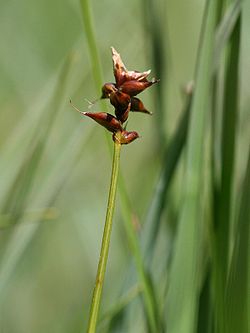| Carex dioica | |
|---|---|
 | |
| A female individual's inflorescence | |
 | |
| A male individual's inflorescence | |
| Scientific classification | |
| Kingdom: | Plantae |
| Clade: | Tracheophytes |
| Clade: | Angiosperms |
| Clade: | Monocots |
| Clade: | Commelinids |
| Order: | Poales |
| Family: | Cyperaceae |
| Genus: | Carex |
| Species: | C. dioica |
| Binomial name | |
| Carex dioica | |
| Synonyms [2] | |
List
| |
Carex dioica, the dioecious sedge (a name it shares with Carex sterilis ), is a species of flowering plant in the genus Carex , native to Iceland, the Faroes, Svalbard, nearly all of Europe, western Siberia, and the Altai. [2] [3] It prefers to live in calcareous fens. [4]